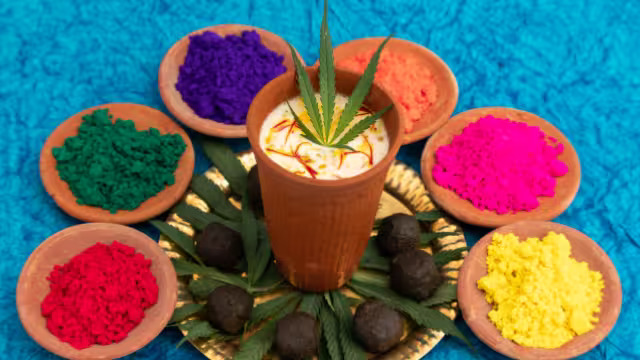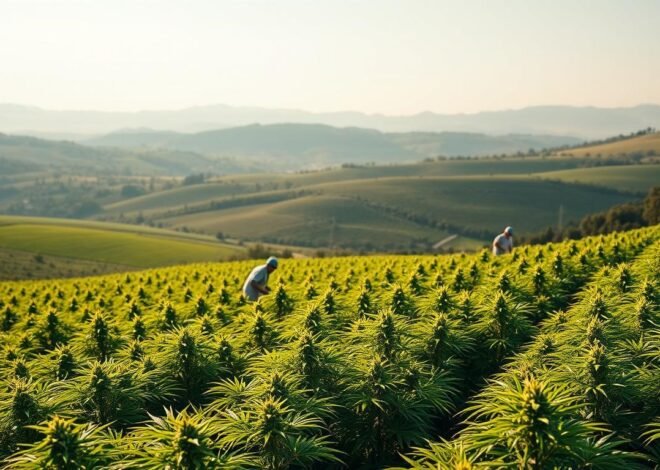
Bhang and Holi: Unraveling the Story
Introduction: Bhang and Holi
Bhang and Holi: Holi marks the onset of summer, much like how thandai marks the celebration of Holi. Adding a touch of herbal relaxation to the traditional summer cooler is bhang, an intriguing ingredient that remains a whispered secret on Holi day. Mixed with thandai, bhang is renowned for its calming effects, offering respite to the mind and body after a day of vibrant color play. But what exactly is bhang, and what is its connection to Holi?
What is Bhang?
Bhang is crafted from the buds and leaves of the potent female cannabis plant. While the cultivation, sale, and consumption of cannabis are generally prohibited in India, there are exceptions to the rule. The law specifically prohibits certain parts of the cannabis plant, yet there is no mention of the leaves, which form the basis of bhang. This legal loophole has led to the existence of government-authorized Bhang shops across India, including prominent locations like Jaisalmer, Varanasi, and Kolkata. However, the regulations surrounding bhang are intricate, with some states permitting sale but not production, while others allow production but not cultivation.
Historical and Mythological Roots: Bhang and Holi
The origins of bhang are deeply intertwined with Hindu mythology. According to legend, the bhang plant emerged during the ‘Sagar Manthan’ or Great Churning of the Ocean by the devas (celestial beings) and asuras (demons). When Lord Shiva consumed the halahal poison that emerged from the churning, his consort Parvati intervened by feeding him bhang as a protective measure, allowing him to endure the toxic effects.
The Connection with Holi: Bhang and Holi
Another tale, also associated with Lord Shiva, sheds light on why bhang is savored during Holi. According to this legend, Shiva entered a deep state of meditation to overcome the sorrow of losing his consort, Sati. In an attempt to draw him out of his trance, Parvati enlisted the help of Kamadeva, the God of Love, who shot an arrow infused with bhang at Shiva. The intoxicating effects of bhang successfully lifted Shiva’s spirits, marking the day of Holi as a celebration of love and happiness, accompanied by a joyful high.
From Thandai to Pakoras: Incorporating Bhang into Your Food
Despite legal restrictions, cannabis manages to find its way into various culinary delights. Thandai infused with bhang is openly sold through numerous outlets across the country, particularly during the festivals of Holi and Maha Shivratri. Bhang Pakoras are another popular Holi delicacy, while in the hills of Uttarakhand, finding bhang ki chutney is not a challenging task. Bhang pedas and even brownies are available, depending on your location and desired level of intoxication during Holi festivities.
Conclusion
Bhang, (Bhang and Holi) with its rich history and cultural significance, remains an integral part of Holi celebrations in India. Despite legal complexities, its association with joy, love, and relaxation persists, making it a cherished component of this festive occasion. As people gather to revel in the colors and festivities of Holi, bhang adds an extra layer of cheer, reminding us of its enduring presence in our traditions and customs.
FAQs about Bhang and Holi
Is bhang legal in India?
While the cultivation, sale, and consumption of cannabis are generally prohibited in India, there are exceptions for certain parts of the cannabis plant. Bhang, made from the leaves and buds, falls into this legal gray area, allowing for government-authorized Bhang shops in some states.
What is the historical significance of bhang in India?
Bhang has deep roots in Hindu mythology, with legends linking its creation to events like the churning of the ocean and the actions of deities like Lord Shiva and Parvati. Its association with festivals like Holi further underscores its cultural importance in India.
How is bhang traditionally consumed during Holi?
During Holi celebrations, bhang is commonly mixed with thandai, a traditional milk-based drink infused with nuts and spices. It is also incorporated into savory snacks like pakoras and chutneys, adding a festive touch to the culinary offerings of the day.
What are the legal regulations surrounding bhang in different states of India?
The legal status of bhang varies from state to state in India. While some states permit its sale but not production, others allow production but not cultivation. Government regulations dictate the licensing and operation of Bhang shops in authorized areas.
Are there any health risks associated with consuming bhang?
While bhang is generally considered safe when consumed in moderation, excessive intake can lead to side effects such as confusion, dry mouth, fatigue, anxiety, and increased heart rate. It’s essential to consume bhang responsibly and be aware of its potential effects on one’s health and well-being.


